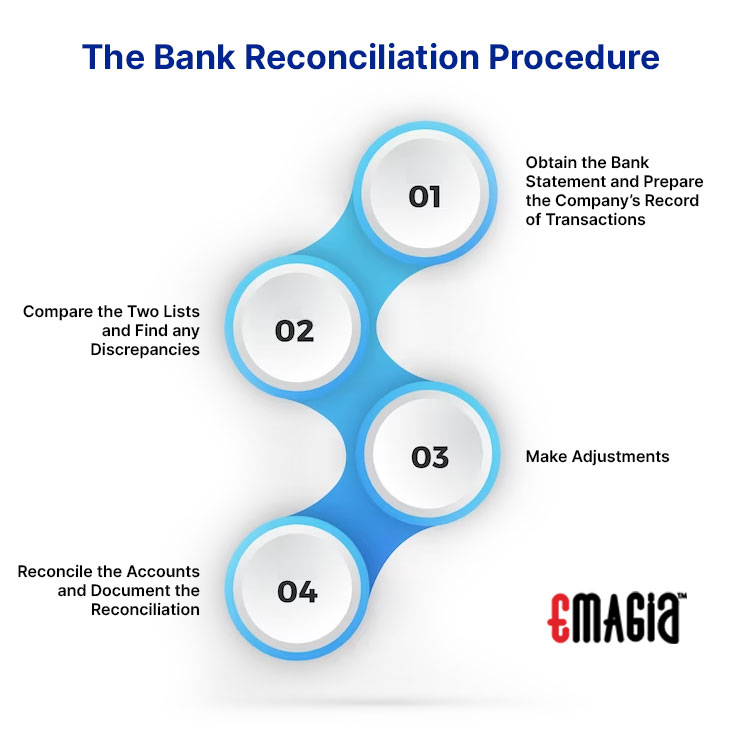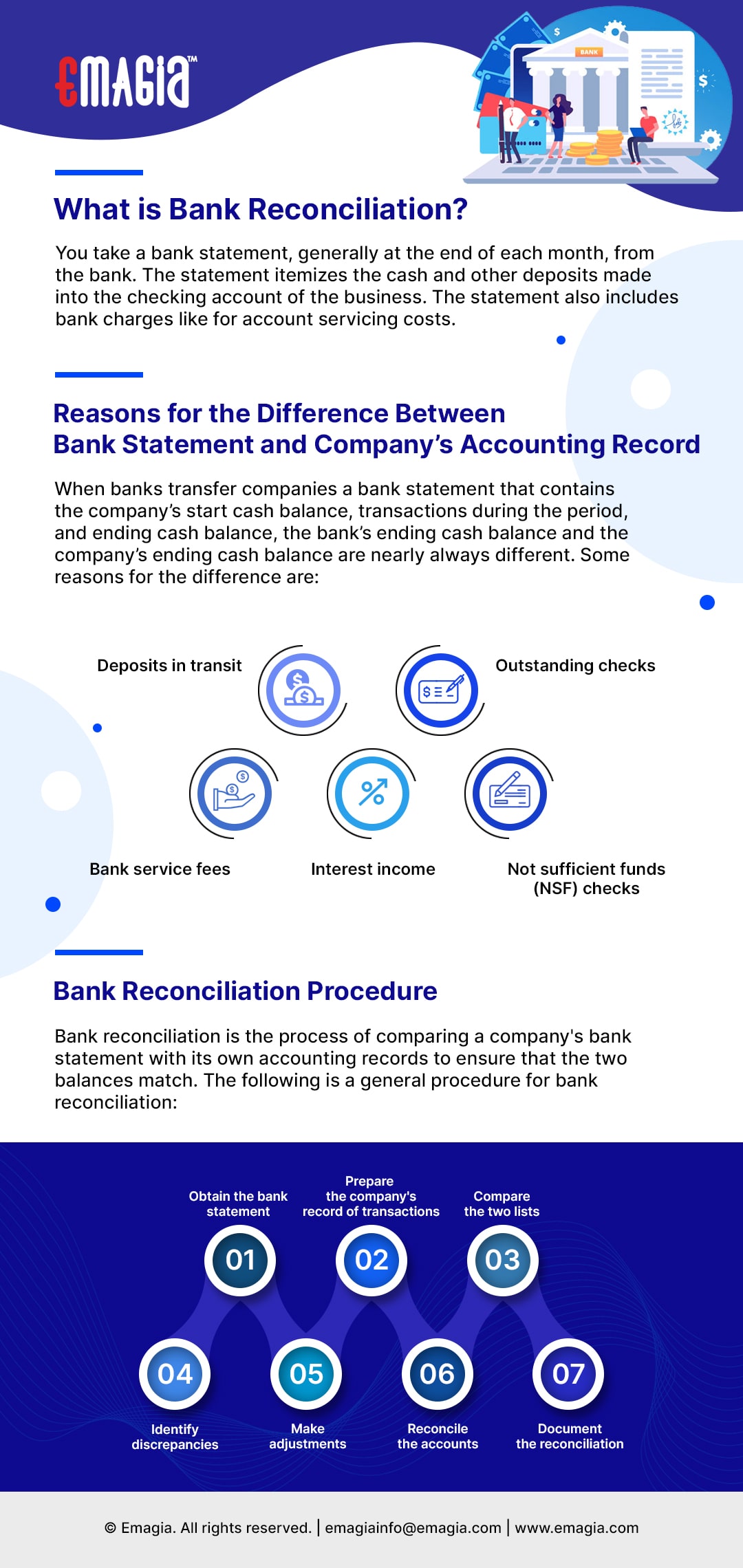
The statements give companies clear pictures of their cash flows, which can help with organizational planning and making critical business decisions. Bank reconciliation is the process of verifying the completeness of a transaction through matching a company’s balance sheet to their bank statement. Not only does the bank provide basic checking services, slam for dummies by søren riisgaard but they process credit card transactions, keep cash safe, and may finance loans when needed. For any reconciling items appearing in the book section, a journal entry should be recorded to adjust the cash account to the correct balance. However, the depositor/customer/company credits its Cash account to decrease its checking account balance.
Step 2. Compare Deposits
- A merchant’s bank account must pay an interchange fee to the card-issuing bank each time someone uses a credit or debit card to purchase something from their store.
- Journal entries, also known as the original book of entries, refer to the process of recording transactions as debits and credits, and once these are recorded, the general ledger is prepared.
- The company can now take steps to rectify the mistakes and balance its statements.
- In this instance, your bank has recorded the receipts in your business account at the bank, while you haven’t recorded this transaction in your cash book.
- Keeping accurate financial statements is the easiest way to simplify your bank reconciliation process.
- If any discrepancies cannot be identified and reconciled, it may signal an error or risk of fraud which your company can investigate further.
11 Financial’s website is limited to the dissemination of general information pertaining to its advisory services, together with access to additional investment-related information, publications, and links. Finance Strategists has an advertising relationship with some of the companies included on this website. We may earn a commission when you click on a link or make a purchase through the links on our site. Nevertheless, on 5 June, when the bank pays the check, the difference will cease to exist. For a more detailed and thorough illustration of a bank reconciliation and to learn the related terminology, be sure to see our topic Bank Reconciliation. My Accounting Course is a world-class educational resource developed by experts to simplify accounting, finance, & investment analysis topics, so students and professionals can learn and propel their careers.
Ensures Financial Accuracy and Cash Flow
This transaction results in the bank’s assets decreasing by $1,000 and its liabilities decreasing by $1,000. Accurate recording keeping is a vital aspect of any businesses and nowhere is this more true that in your… Someone on our team will connect you with a financial professional in our network holding the correct designation and expertise. Finance Strategists is a leading financial education organization that connects people with financial professionals, priding itself on providing accurate and reliable financial information to millions of readers each year. This team of experts helps Finance Strategists maintain the highest level of accuracy and professionalism possible. Our team of reviewers are established professionals with decades of experience in areas of personal finance and hold many advanced degrees and certifications.
Step 1: Find the starting balance
When the business receives its bank statement, it can use the final amounts of interest and investment income to make adjustments and reconcile its financial statements. Compare the business’s financial records to the bank statement to spot the errors. This can be accomplished by matching transactions, and then adding or deducting any transactions that do not align to balance the total amounts. Using cloud accounting software, like Quickbooks, makes preparing a reconciliation statement easy.
Where Do Non-Sufficient Funds (NSF) Checks Go on a Bank Reconciliation?
If there is so little activity in a bank account that there really is no need for a periodic bank reconciliation, you should question why the account even exists. It may be better to terminate the account and roll any residual funds into a more active account. By doing so, it may be easier to invest the residual funds, as well as to monitor the status of the investment. Once the balances are equal, businesses need to prepare journal entries to adjust the balance per books. After adjusting the balances as per the bank and as per the books, the adjusted amounts should be the same.
Taking the time to perform a bank reconciliation can help you manage your finances and keep accurate records. This relatively straightforward and quick process provides a clear picture of your financial health. Consider reconciling your bank account monthly, whether you set aside a specific day each month or do it as your statements arrive.
However, you typically only have a limited period, such as 30 days from the statement date, to catch and request correction of errors. This practical article illustrates the key points of why a bank reconciliation is important for both business and personal reasons. The accountant should review the outstanding checks with the intention of investigating any extremely old ones.

Kevin’s work has been featured in Bankrate, Credible, CreditCards.com, Fox Money, LendingTree, MarketWatch, Newsweek, New York Post, Time, ValuePenguin and USA Today. At times, you might give standing instructions to your bank to make payments regularly on specific days to third parties, such as insurance premiums, telephone bills, rent, sales taxes, etc. At Business.org, our research is meant to offer general product and service recommendations.
Let’s assume that a new company opens its first checking account on June 4 with a deposit of $10,000. It also made a $2,000 deposit in the bank’s night depository after banking hours on June 30. As a result, the company’s Cash account (in its general ledger and referred to as the “books”) as of June 30 shows a positive, debit balance of $7,000. Consider performing this monthly task shortly after your bank statement arrives so you can manage any errors or improper transactions as quickly as possible. Bank reconciliation isn’t just important for maintaining accurate business finances—it also ensures your customer and business relationships remain strong. Regular bank reconciliation double-checks that all payments have been accurately processed.
At times, the balance as per the cash book and passbook may differ due to an error committed by either the bank or an error in the cash book of your company. There are times when your business will deposit a check or draw a bill of exchange discounted with the bank. These deposited checks or discounted bills of exchange drawn by your business may get dishonored on the date of maturity. As a result, the bank debits the amount against such dishonored cheques or bills of exchange to your bank account.
This includes payments by customers to your company and payments from your company to employees, contractors, and other goods and services providers. Conducting regular bank reconciliation helps you catch any fraud risks or financial errors before they become a larger problem. This includes everything from major fraud and theft to accounting miscalculations, insufficient funds, and incomplete or duplicated payments. An NSF (not sufficient funds) check is a check that has not been honored by the bank due to insufficient funds in the entity’s bank accounts. This means that the check amount has not been deposited in your bank account and hence needs to be deducted from your cash account records. The purpose of reconciling the bank statement with your business’ books of accounts is to identify any differences between the balance of the two accounts and to ensure the balance as per the bank statement is correct.
